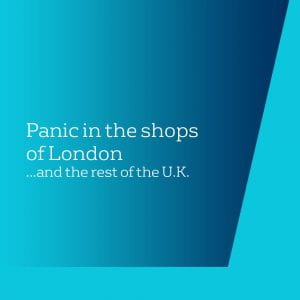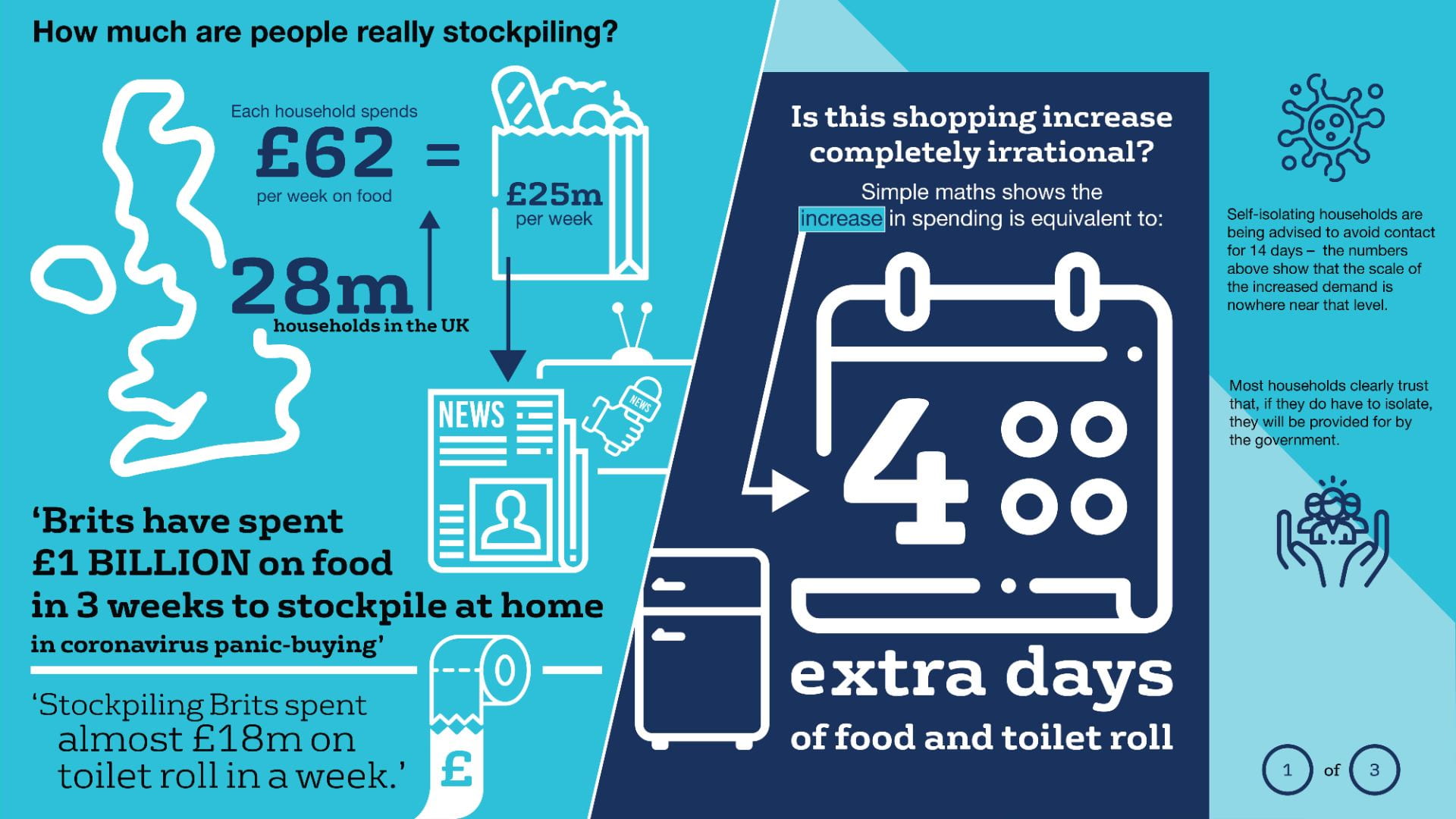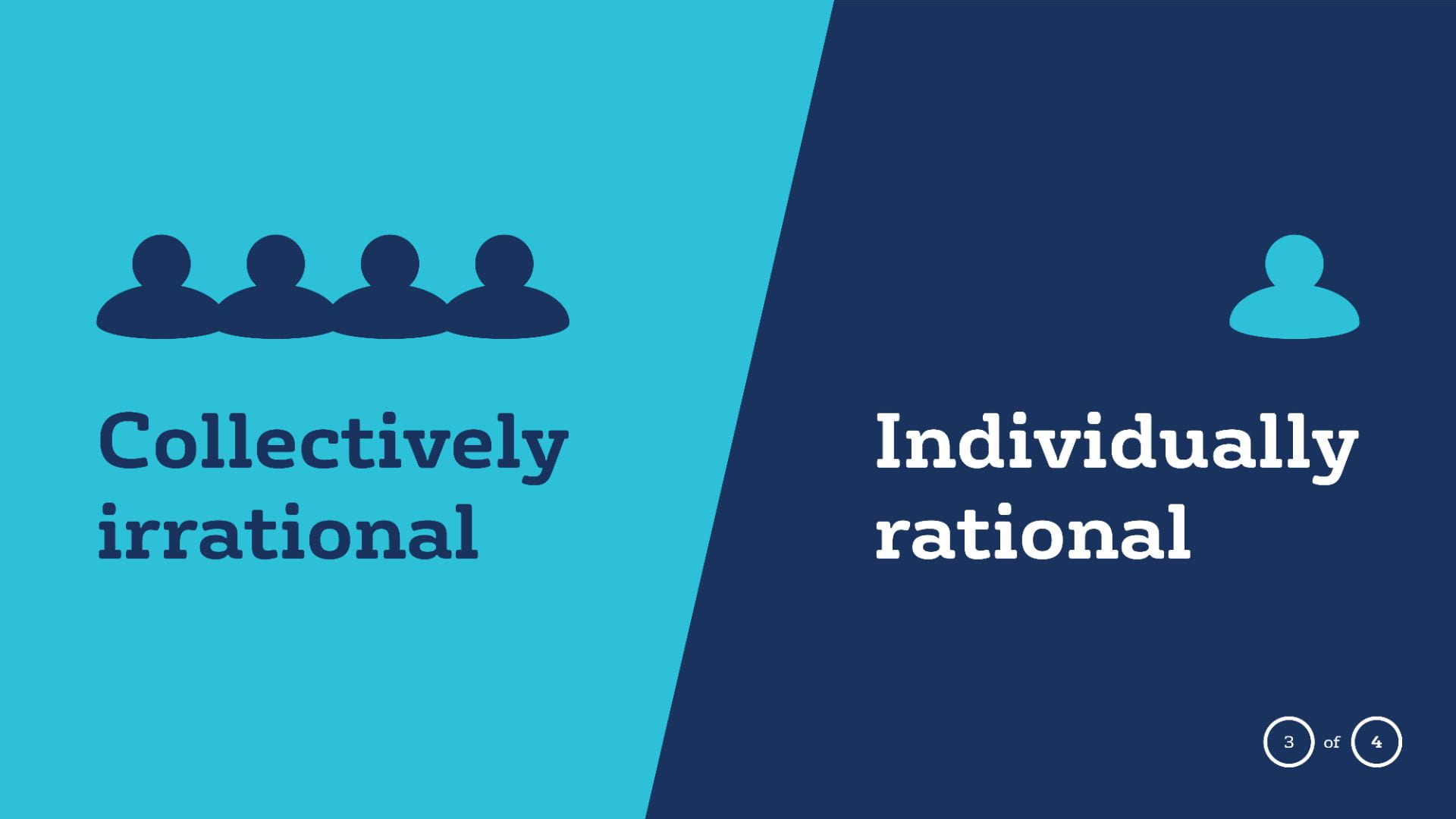 Economics provides a useful toolbox to make sense of the current crisis. Department of Economics staff are writing about coronavirus for different audiences, including launching a blog for 6th formers who are stuck at home.
Economics provides a useful toolbox to make sense of the current crisis. Department of Economics staff are writing about coronavirus for different audiences, including launching a blog for 6th formers who are stuck at home.
In the first of these, Sarah Smith, looks at why there was no toilet roll in the supermarket.
In recent days, the media headlines have screamed news that Brits have spent £1 BILLION on food in 3 weeks to stockpile at home in coronavirus panic-buying and Stockpiling Brits spent almost £18m on toilet roll in a WEEK.
The tone of the coverage is that so-called panic-buying is both unnecessary and fundamentally wrong. There have been reports of anti-social behaviour – toilet rolls being taken out of a food bank donation bin and even a blind person’s trolley. The increased spending also has negative externalities – i.e. negative effects on other people that shoppers don’t take into account. A nurse posted a heart-breaking video after she arrived at the supermarket exhausted after a day’s shift only to find empty shelves. But before dismissing the increased shopping as completely irrational, as many have done, let’s look in more detail at the micro-economics of the coronavirus panic-buying and ask (when) is coronavirus panic-buying rational?
 How much are people really stock-piling?
How much are people really stock-piling?
It’s easy to be fooled by big numbers. £1 billion worth of food or £18 million worth of toilet roll sounds like a lot – and certainly would be for one household. But there are 28 million households in the UK. Each of them spends, on average, nearly £62 a week on food (that’s a total of £1.7 billion a week) and 90 pence on toilet roll (a total of more than £25 million). Some simple maths shows that the increase in spending is equivalent to, roughly, four extra days of food and toilet roll. It’s a sizeable increase but people are not building up huge reserves. Households who are self-isolating are advised to avoid contact for 14 days; the scale of the increased demand is nowhere near that level. Most households clearly trust that, if they do have to isolate, they will be provided for by the government.
 The supply (chain) side
The supply (chain) side
The fact that the shelves were often bare (particularly where the toilet roll should have been) gives us an insight into the way modern supermarkets work. Their efficient supply chains mean that they can hold relatively low reserves – but this makes them vulnerable to changes in demand that they don’t anticipate. They plan for and deal with seasonal fluctuations, such as Christmas, but unanticipated increases in demand, even if they are relatively small, cause them to run out. From the supermarkets’ point of view, it is plausibly rational that they run out of toilet roll more than they did other goods. Toilet roll is relatively bulky and takes up a lot of space and is costly for supermarkets to stock; toilet roll is also a low margin product (supermarkets don’t make a lot of profit on it) so the value of being able to respond to an unanticipated increase in demand is small. Also, in normal circumstances, demand for toilet roll is fairly regular so, again, there is limited benefit in holding reserves.
As an aside, once you understand that it is costly for supermarkets to hold supplies of bulky goods, it is easy to see why Easter eggs have been on sale since January; supermarkets are flattening their demand curves and reducing the need to hold stocks.
 The demand side
The demand side
At least some of the increase in spending on food and toilet roll is likely to be a rational response to a change in daily activity. People are no longer socialising and are working from home more – and having to feed kids who are no longer at school. In a typical week, UK households spend, on average, more than £20 on restaurant, café and canteen meals. A lot of that demand has switched to home consumption and many households now have a genuine need for more food and toilet roll.
An academic study carried out during the aftermath of a major earthquake in Japan provides further insight into how shoppers change their behaviour and cause apparent panic-buying. Analysing very detailed supermarket scanner data, the researchers found that the overall increase in spending was driven mainly by an increase in the number of households that shopped, rather than an increase in spending by each household. When the researchers looked at who was “panic-buying” they found that increased shopping was more common among larger households (who are more likely to have a genuine need for food) and households with a middle-aged (or older) full-time homemaker for whom the (opportunity) cost of increased shopping is lower. This suggests that some “rational” cost-benefit calculations underly the change in shopping behaviour.
“The Run on Daily Foods and Goods after the 2011 Tohoku Earthquake” by Masahiro Hori and Koichiro Iwamoto. The Japanese Political Economy, Dec 2014.
 Collectively irrational, individually rational
Collectively irrational, individually rational
The definition of panic buying is buying that is not linked to an increase in need. It occurs when people buy more than they need out of a fear that supermarkets will run out. Collectively, it is irrational for people to do this. If everyone buys just enough, then, unless there is a disruption to supply, supermarkets will not run out. But panic-buying becomes a self-fulfilling prophecy. If people buy more than they need out of a fear that supermarkets will run out, then exactly the thing that everyone is fearing will happen and supermarket shelves will be empty.
Although panic-buying is collectively irrational, it is individually rational. Anticipating that supermarkets will run out, you as an individual want to make sure that you don’t miss out and don’t turn up when the shelves are empty. This type of behaviour is an example of strategic interaction, i.e. people think about – and take account of – the actions of others when choosing their own actions. In economics, and other social science disciplines, game theory offers a set of tools for understanding and modelling these strategic interactions in a more formal way.
Here’s what panic-buying looks like as a simple game theory model. Suppose there are two shoppers – Ahmed and Bella. Each of them needs one pack of toilet roll each week. The supermarket supplies two packs each week, meaning that both can buy what they need. Suppose the coronavirus hits. The underlying supply of toilet rolls is not affected and (in this example) suppose demand is unchanged but there is now an element of uncertainty. Ahmed and Bella worry that future supply might be affected; they might also worry that other people start to buy more. They face a choice between two actions – 1. buy one pack or 2. if they are the first to turn up to the supermarket buy two packs on a “just in case” basis.
The set of possible actions and associated outcomes for Ahmed and Bella are summarised in the table below. The collectively rational set of actions is for each of them is to buy only one pack (the set of actions, A1, B1) but the individually rational action for the first of them to get to the supermarket is to buy two packs (A2, B2). Moreover, knowing that the first to get to the supermarket will buy two packs, there is also an incentive to turn up early to the supermarket.
| A’s actions | ||
| B’s actions | A1. Buy one pack | A2. Buy two packs |
|
B1. Buy one pack |
A and B both get what they need |
B gets enough this week if she arrives first, but may worry about what happens next week; A gets enough for this week and next if he arrives first (and enough for this week if he arrives second) |
|
B2. Buy two packs |
A gets enough this week if he arrives first, but may worry about what happens next week; B gets enough for this week and next if she arrives first (and enough for this week if she arrives second) |
50:50 chance for A and B of getting enough for this week and next |
The panic-buying “game” is an example of the classic game theory model, the prisoners’ dilemma. This involves two people who are accused of a crime. They are faced with a choice between 1. confessing and giving evidence against the other or 2. remaining silent. If both confess, each gets the full punishment for the jointly-committed crime (15 years each). If both remain silent, they will be charged with a lesser crime and be sentenced to five years each. But if only one confesses (while the other remains silent) the confessor will be let off, while the one who remains silent gets 20 years. The collectively rational action is to be silent, but the temptation (the individually rational action) is always to confess.
Game theory
The game theory model provides insights into how to tackle panic-buying by highlighting some of the underlying problems. One of the problems is a co-ordination failure. People will not co-ordinate on buying one pack if they believe that others have an incentive to buy two. The government and supermarkets can help to solve this problem by enforcing co-ordination through rationing demand which is why many supermarkets have introduced limits on the number of units that people can buy. Note that this is very different to rationing during and after the second world war which was a response to reduced supply rather than a response to a co-ordination failure. Another underlying problem is an information failure. The incentive to buy two packs arises because shoppers believe that supply may be disrupted. The government and supermarkets are repeatedly trying to reassure people that there is plenty of supply. The problem is that the sight of bare shelves, not to mention the extensive media coverage of panic-buying, sends the opposite message.
In this case, the newspaper headlines fuel the very activity that is being reported on.

